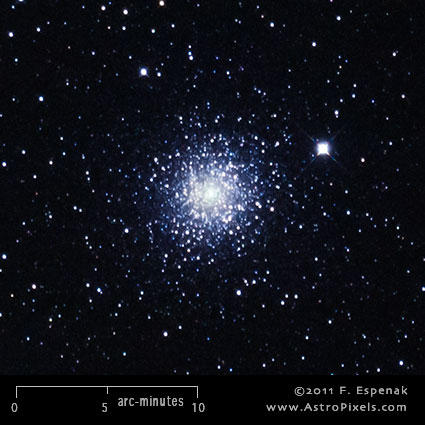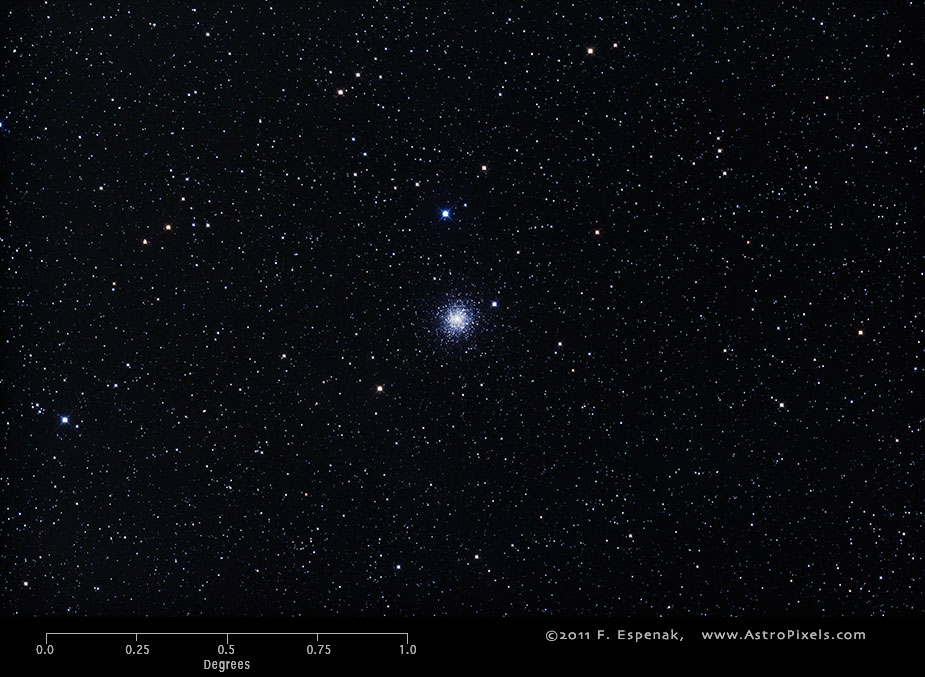
M15 - Great Pegasus Globular
Messier 15 or M15 (also designated NGC 7078) is a globular cluster in the constellation Pegasus. It has an apparent visual magnitude of 6.2 and its angular diameter is 12.3 arc-minutes. M15 lies at an estimated distance of 33,600 light years. The Equinox 2000 coordinates are RA= 21h 30m, Dec= +12° 10´ which makes M15 best seen during the autumn. The Messier Autumn Star Chart shows the position of all Messier objects visible during that season. As one of the more famous objects in the Messier Catalog, it is commonly known as the Great Pegasus Cluster.
The image above shows the uncropped view of M15 through the Takahashi E-180 Astrograph (North is to right). A 3x enlargement of this image appears to the right.
In spite of its inclusion in the Messier Catalog, this globular cluster was actually discovered by G. D. Maraldi in 1746. According to Recio-Blanco et al.(2005), the distance of M15 is 39,010 light years and its diameter is 200 light years. Its estimated mass is 450,000 solar masses and it contains 131 variable stars.
For more information, see the Messier Catalog as well as specific entries for M15 in Wikipedia and SEDS.
Messier's Description of M15
June 3, 1764
`Nebula without a star, between the head of Pegasus and that of Equuleus; it is round, in the center it is brilliant, its position was determined by comparison with Delta Equulei. M. Maraldi, in the Memoirs of the Academy of 1746, reports of this nebula: "I have found, he says, between the stars Epsilon Pegasi and Beta Equulei, a fairly bright nebulous star, which is composed of many stars; its right ascension is 319d 27' 6", and its northern declination is 11d 2' 22".' (diam. 3')
Technical Details
- Object: M15
- Other Names: NGC 7078, Great Pegasus Cluster
- Object Type: globular cluster
- Object Data: Apparent Magnitude = 6.2, Angular Size = 12.3 arc-minutes
- Object Position (Equinox 2000): RA= 21h 30m, Dec= +12° 10´, Constellation = Pegasus
- Date/Time: 2011 Oct 20 at 03:37 UTC
- Location: Bifrost Astronomical Observatory, Portal, AZ
- Mount: Astro-Physics 1200GTO
- Telescope: Takahashi Epsilon 180 Hyperbolic Astrograph
- Camera: Canon EOS 550D (Rebel T2i) (modified with a Baader UV/IR filter)
- Field of View: 1.70° x 2.56° at 1.7 arc-sec/pixel (web version: 10.0 arc-sec/pixel)
- Exposure: 12 x 300s, f/2.8, ISO 800
- File Name: M15-01w.jpg
- Processing (Adobe Camera Raw): Graduated Filter, Vignetting Correction, Noise Reduction, White Balance, Curves
- Processing (Photoshop CS5): Average Images, Curves, Noise Reduction
- Original Image Size: 3454 × 5179 pixels (17.9 MP); 11.5" x 17.3" @ 300 dpi
- Rights: Copyright 2011 by Fred Espenak. All Rights Reserved. See: Image Licensing.
